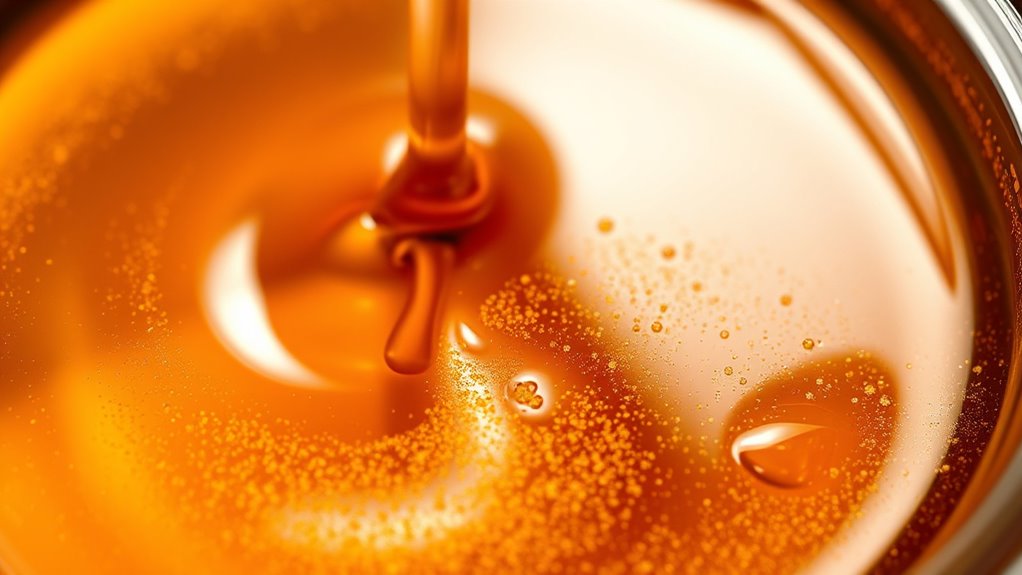To optimize body and mouthfeel, you need to control extraction methods carefully—using gentle techniques like cold-pressing helps maintain delicate flavors and textures. Managing residual fines through filtration or centrifuging ensures a smooth, gritty-free product that feels rich and refined on the palate. Proper extraction preserves the plant’s natural profile while reducing harshness, resulting in a better experience. Continuing will reveal how fine-tuning these processes can elevate your product even further.
Key Takeaways
- Proper extraction techniques preserve delicate flavor compounds, enhancing overall body and mouthfeel.
- Managing fines through filtration and centrifuging ensures a smoother, less gritty product with improved texture.
- Gentle methods like cold-pressing minimize volatile compound loss, maintaining rich flavor and a balanced mouthfeel.
- Excess residual fines negatively impact the sensory experience, causing harshness and reducing product refinement.
- Optimizing extraction processes and fines management results in oils that are both potent and sensorially refined.

Have you ever wondered how oils, fines, and extraction processes work together in the world of cannabis or other plant-based industries? It’s a fascinating interplay that directly impacts the body and mouthfeel of the final product. At its core, the goal is to maximize the quality of the extract while preserving the plant’s natural flavor profile. This is where understanding extraction techniques becomes essential. Different methods, like solvent-based, CO2, or solventless extraction, each have unique ways of pulling out desirable compounds, but they also influence the presence of fines and residual plant material. Properly executed, these techniques help retain the richness of flavors and textures, providing a more authentic and enjoyable experience.
Proper extraction techniques preserve flavor and texture by managing fines and residual plant material.
In the context of flavor preservation, the extraction process is indispensable. When you choose the right method, you protect delicate terpenes and aromatic compounds that give each strain its distinct character. For example, gentle extraction techniques like cold-pressing or low-temperature methods minimize the degradation of volatile compounds, ensuring you get a product that’s both potent and flavorful. Conversely, harsher methods might extract more cannabinoids but risk stripping away nuanced flavors, resulting in a less complex mouthfeel. So, understanding how different extraction techniques influence flavor retention can make all the difference in your final product.
Fines—tiny particles of plant material—are an unavoidable byproduct of extraction, and managing them is essential for a smooth body and mouthfeel. If fines aren’t properly filtered out, they can create a gritty, harsh sensation that detracts from the overall experience. This is why post-extraction steps like filtration and centrifuging are so important—they help remove residual fines, ensuring a cleaner, more refined product. When you pay attention to these details, you’ll notice a significant improvement in the texture and overall quality of your oils, making them more enjoyable to consume.
The relationship between oils, fines, and extraction processes is delicate but fundamental. When executed correctly, it results in a product that’s rich in flavor, smooth in texture, and true to the plant’s natural profile. As you explore different extraction techniques, keep in mind how each stage impacts body and mouthfeel. With careful handling and attention to detail, you can craft extracts that deliver a premium experience—both in taste and texture—that highlights the full potential of the plant’s qualities. Additionally, understanding extraction techniques can help optimize the removal of fines and improve overall product clarity and consistency.
Frequently Asked Questions
How Do Different Oils Affect the Overall Flavor Profile?
Different oils considerably influence your coffee’s flavor profile by enhancing aromatic profiles and adding subtle complexity. When you choose specific oils, you can boost flavor enhancement, making fruity, nutty, or spicy notes stand out more vividly. Oils also contribute to the overall mouthfeel, giving your coffee a richer, smoother texture. Experimenting with various oils allows you to tailor your brew’s aroma and taste, creating a more personalized and enjoyable coffee experience.
Can Extraction Methods Influence the Body and Mouthfeel of the Final Product?
Extraction techniques directly influence the body and mouthfeel of your final product by controlling how oils and fines are pulled from the material. For example, using gentle methods like cold extraction can enhance mouthfeel, making it smoother and richer. By choosing the right extraction process, you can tailor the product’s viscosity and texture, ensuring a more satisfying sensory experience. Proper extraction is essential for mouthfeel enhancement and achieving your desired beverage profile.
What Role Do Fines Play in the Texture of Beverages?
Did you know fines can make up over 10% of coffee grounds? Fines impact the beverage’s texture profoundly, often contributing to a smoother, richer mouthfeel. They can enhance body by filling in gaps between larger particles, creating a more uniform extraction. This texture enhancement results in a fuller, more balanced drink, giving you a better sensory experience. So, managing fines can truly elevate your beverage’s overall mouthfeel.
How Does Temperature Impact Oil and Fines Extraction?
Temperature control substantially impacts oil and fines extraction by enhancing extraction efficiency. When you increase the temperature, oils dissolve more readily, allowing for a richer body and mouthfeel. Conversely, higher temperatures can also extract more fines, which may affect clarity and texture. By carefully managing temperature, you optimize extraction efficiency, balancing desirable flavors and textures while minimizing unwanted fines, ultimately improving the beverage’s overall quality.
Are There Health Implications Related to Oils and Fines in the Final Product?
Think of oils and fines like hidden traps in your final product. They can pose health risks if toxins are present or if contaminants remain. Consuming products with excessive or unfiltered oils might lead to health implications over time, much like the dangers lurking in a Trojan horse. To avoid toxin presence and health risks, guarantee proper extraction and filtration, keeping your product safe and enjoyable.
Conclusion
By understanding oils, fines, and extraction, you gain control over body and mouthfeel. You can enhance richness, refine clarity, and optimize flavor. You can adjust grind size, brewing time, and temperature to shape each sip. You can experiment with variables to find your perfect balance. Because when you grasp these elements, you craft not just coffee, but an experience—an experience that’s rich, smooth, and uniquely yours.








